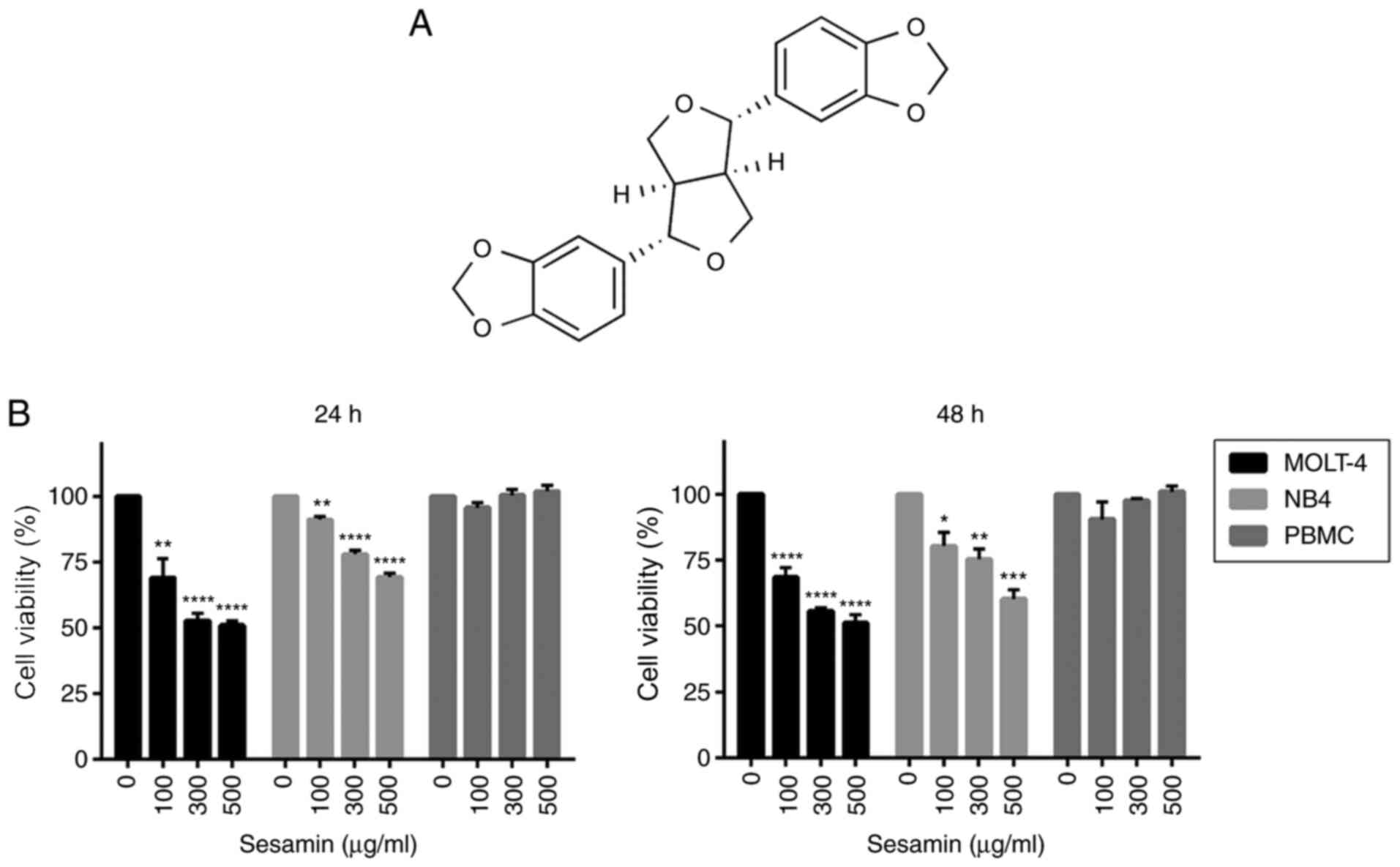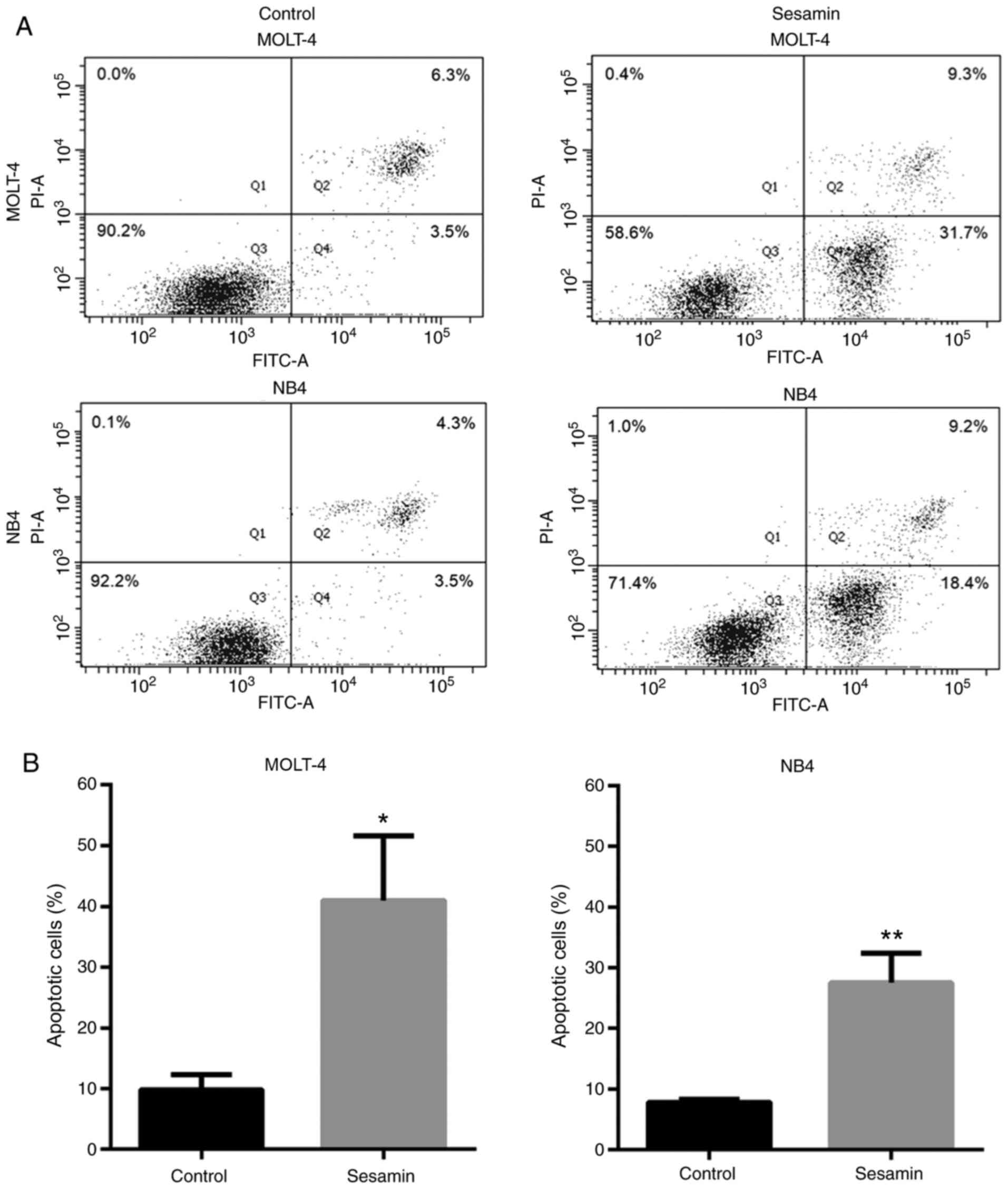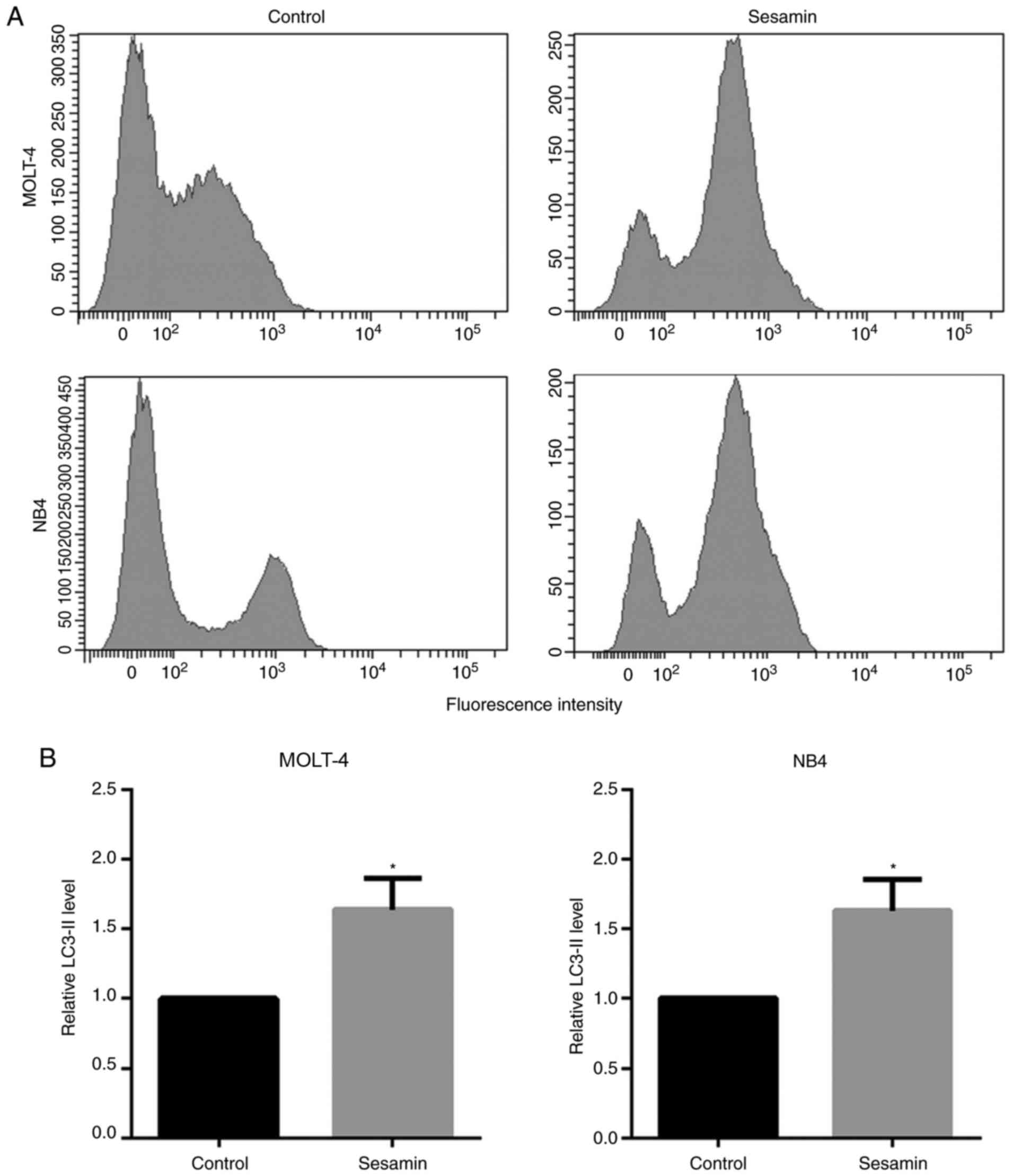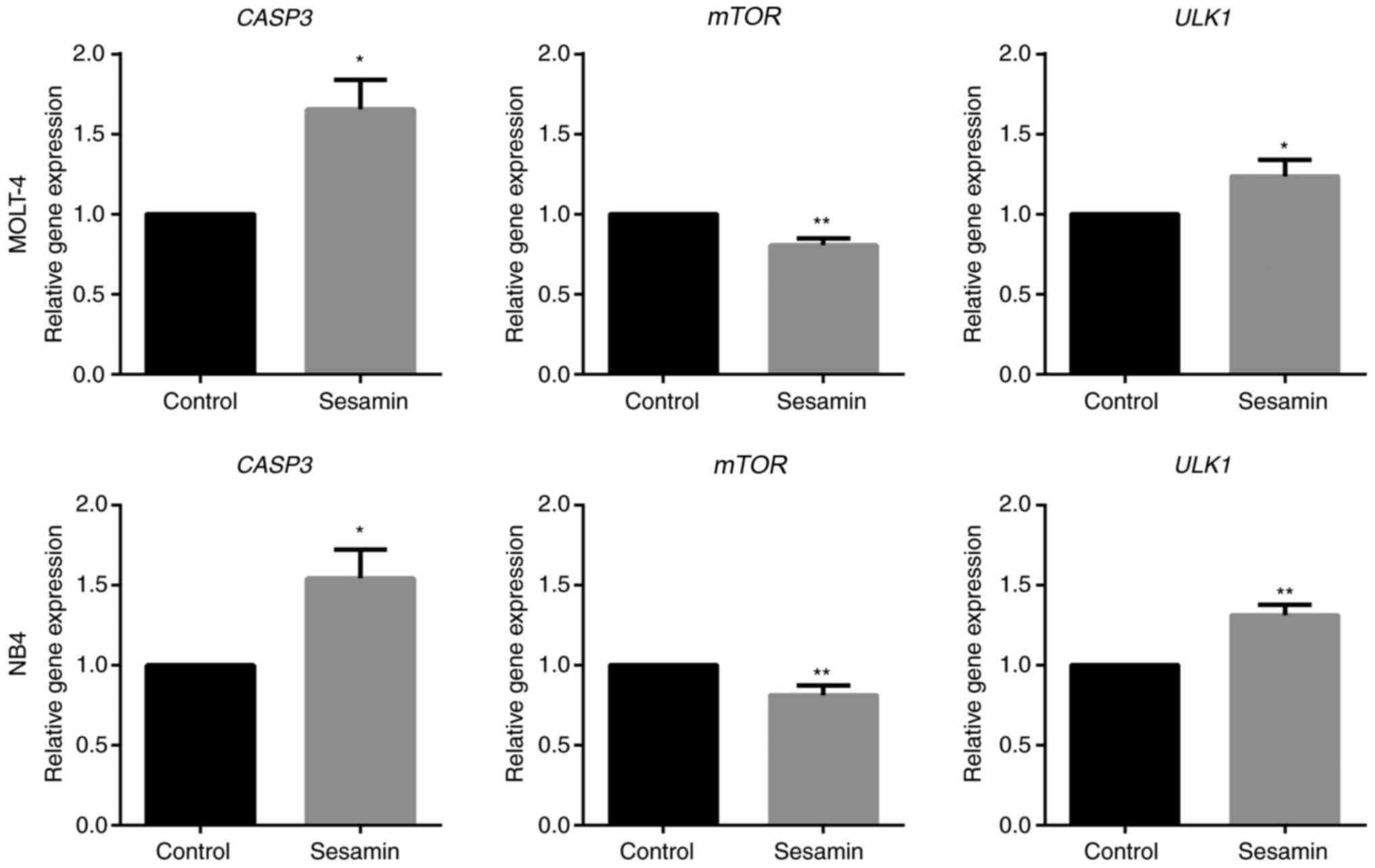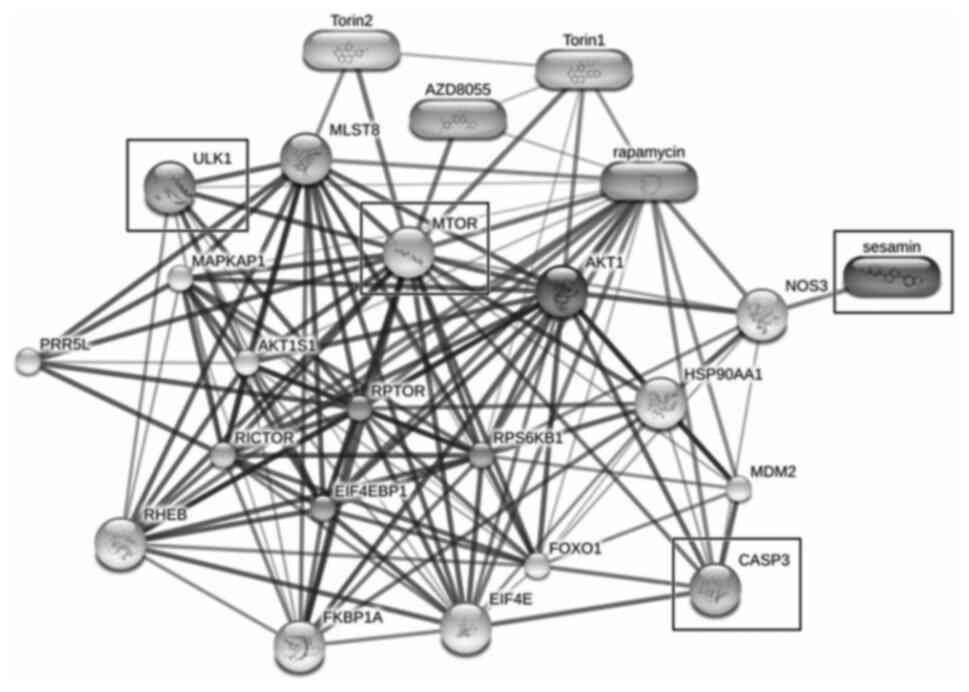|
1
|
Wong SW, Lenzini S and Shin JW:
Perspective: Biophysical regulation of cancerous and normal blood
cell lineages in hematopoietic malignancies. APL Bioeng.
2:0318022018. View Article : Google Scholar : PubMed/NCBI
|
|
2
|
Bray F, Ferlay J, Soerjomataram I, Siegel
RL, Torre LA and Jemal A: Global cancer statistics 2018: GLOBOCAN
estimates of incidence and mortality worldwide for 36 cancers in
185 countries. CA Cancer J Clin. 68:394–424. 2018. View Article : Google Scholar : PubMed/NCBI
|
|
3
|
Ramirez LY, Huestis SE, Yap TY, Zyzanski
S, Drotar D and Kodish E: Potential chemotherapy side effects: What
do oncologists tell parents? Pediatr Blood Cancer. 52:497–502.
2009. View Article : Google Scholar : PubMed/NCBI
|
|
4
|
Saedi TA, Md Noor S, Ismail P and Othman
F: The effects of herbs and fruits on leukaemia. Evid Based
Complement Alternat Med. 2014:4941362014. View Article : Google Scholar : PubMed/NCBI
|
|
5
|
Moazzami AA, Haese SL and Kamal-Eldin A:
Lignan contents in sesame seeds and products. Eur J Lipid Sci
Technol. 109:1022–1027. 2007. View Article : Google Scholar
|
|
6
|
Ruankham W, Suwanjang W, Wongchitrat P,
Prachayasittikul V, Prachayasittikul S and Phopin K: Sesamin and
sesamol attenuate H2O2-induced oxidative
stress on human neuronal cells via the SIRT1-SIRT3-FOXO3a signaling
pathway. Nutr Neurosci. 1–12. 2019.(Epub ahead of print).
View Article : Google Scholar : PubMed/NCBI
|
|
7
|
Kong P, Chen G, Jiang A, Wang Y, Song C,
Zhuang J, Xi C, Wang G, Ji Y and Yan J: Sesamin inhibits
IL-1β-stimulated inflammatory response in human osteoarthritis
chondrocytes by activating Nrf2 signaling pathway. Oncotarget.
7:83720–83726. 2016. View Article : Google Scholar : PubMed/NCBI
|
|
8
|
Miyawaki T, Aono H, Toyoda-Ono Y, Maeda H,
Kiso Y and Moriyama K: Antihypertensive effects of sesamin in
humans. J Nutr Sci Vitaminol (Tokyo). 55:87–91. 2009. View Article : Google Scholar : PubMed/NCBI
|
|
9
|
Liang YT, Chen J, Jiao R, Peng C, Zuo Y,
Lei L, Liu Y, Wang X, Ma KY, Huang Y and Chen ZY:
Cholesterol-lowering activity of sesamin is associated with
down-regulation on genes of sterol transporters involved in
cholesterol absorption. J Agric Food Chem. 63:2963–2969. 2015.
View Article : Google Scholar : PubMed/NCBI
|
|
10
|
Majdalawieh AF, Massri M and Nasrallah GK:
A comprehensive review on the anti-cancer properties and mechanisms
of action of sesamin, a lignan in sesame seeds (Sesamum
indicum). Eur J Pharmacol. 815:512–521. 2017. View Article : Google Scholar : PubMed/NCBI
|
|
11
|
Fang Q, Zhu Y, Wang Q, Song M, Gao G and
Zhou Z: Suppression of cyclooxygenase 2 increases chemosensitivity
to sesamin through the Akt-PI3K signaling pathway in lung cancer
cells. Int J Mol Med. 43:507–516. 2019.PubMed/NCBI
|
|
12
|
Siao AC, Hou CW, Kao YH and Jeng KC:
Effect of sesamin on apoptosis and cell cycle arrest in human
breast cancer mcf-7 cells. Asian Pac J Cancer Prev. 16:3779–3783.
2015. View Article : Google Scholar : PubMed/NCBI
|
|
13
|
Tanabe H, Kuribayashi K, Tsuji N, Tanaka
M, Kobayashi D and Watanabe N: Sesamin induces autophagy in colon
cancer cells by reducing tyrosine phosphorylation of EphA1 and
EphB2. Int J Oncol. 39:33–40. 2011.PubMed/NCBI
|
|
14
|
Dou H, Yang S, Hu Y, Xu D, Liu L and Li X:
Sesamin induces ER stress-mediated apoptosis and activates
autophagy in cervical cancer cells. Life Sci. 200:87–93. 2018.
View Article : Google Scholar : PubMed/NCBI
|
|
15
|
Banjerdpongchai R, Yingyurn S and
Kongtawelert P: Sesamin induces human leukemic cell apoptosis via
mitochondrial and endoplasmic reticulum stress pathways. World J
Oncol. 1:78–86. 2010.PubMed/NCBI
|
|
16
|
Harikumar KB, Sung B, Tharakan ST, Pandey
MK, Joy B, Guha S, Krishnan S and Aggarwal BB: Sesamin manifests
chemopreventive effects through the suppression of NF-kappa
B-regulated cell survival, proliferation, invasion, and angiogenic
gene products. Mol Cancer Res. 8:751–761. 2010. View Article : Google Scholar : PubMed/NCBI
|
|
17
|
Livak KJ and Schmittgen TD: Analysis of
relative gene expression data using real-time quantitative PCR and
the 2(-Delta Delta C(T)) method. Methods. 25:402–408. 2001.
View Article : Google Scholar : PubMed/NCBI
|
|
18
|
Kuhn M, von Mering C, Campillos M, Jensen
LJ and Bork P: STITCH: Interaction networks of chemicals and
proteins. Nucleic Acids Res. 36:D684–D688. 2008. View Article : Google Scholar : PubMed/NCBI
|
|
19
|
Deng P, Wang C, Chen L, Wang C, Du Y, Yan
X, Chen M, Yang G and He G: Sesamin induces cell cycle arrest and
apoptosis through the inhibition of signal transducer and activator
of transcription 3 signalling in human hepatocellular carcinoma
cell line HepG2. Biol Pharm Bull. 36:1540–1548. 2013. View Article : Google Scholar : PubMed/NCBI
|
|
20
|
Wei C, Chen C, Cheng Y, Zhu L, Wang Y, Luo
C, He Y, Yang Z and Ji Z: Ailanthone induces autophagic and
apoptotic cell death in human promyelocytic leukemia HL-60 cells.
Oncol Lett. 16:3569–3576. 2018.PubMed/NCBI
|
|
21
|
Chu YL, Ho CT, Chung JG, Rajasekaran R and
Sheen LY: Allicin induces p53-mediated autophagy in Hep G2 human
liver cancer cells. J Agric Food Chem. 60:8363–8371. 2012.
View Article : Google Scholar : PubMed/NCBI
|
|
22
|
Suangtamai T and Tanyong DI: Diallyl
disulfide induces apoptosis and autophagy via mTOR pathway in
myeloid leukemic cell line. Tumour Biol. 37:10993–10999. 2016.
View Article : Google Scholar : PubMed/NCBI
|
|
23
|
Kim J and Guan KL: mTOR as a central hub
of nutrient signalling and cell growth. Nat Cell Biol. 21:63–71.
2019. View Article : Google Scholar : PubMed/NCBI
|
|
24
|
Hua H, Kong Q, Zhang H, Wang J, Luo T and
Jiang Y: Targeting mTOR for cancer therapy. J Hematol Oncol.
12:712019. View Article : Google Scholar : PubMed/NCBI
|
|
25
|
Liu L, Yan L, Liao N, Wu WQ and Shi JL: A
review of ULK1-mediated autophagy in drug resistance of cancer.
Cancers (Basel). 12:3522020. View Article : Google Scholar
|
|
26
|
Aryal P, Kim K, Park PH, Ham S, Cho J and
Song K: Baicalein induces autophagic cell death through AMPK/ULK1
activation and downregulation of mTORC1 complex components in human
cancer cells. FEBS J. 281:4644–4658. 2014. View Article : Google Scholar : PubMed/NCBI
|
|
27
|
Zhang L, Fu L, Zhang S, Zhang J, Zhao Y,
Zheng Y, He G, Yang S, Ouyang L and Liu B: Discovery of a small
molecule targeting ULK1-modulated cell death of triple negative
breast cancer in vitro and in vivo. Chem Sci. 8:2687–2701. 2017.
View Article : Google Scholar : PubMed/NCBI
|
|
28
|
Xia X: Bioinformatics and drug discovery.
Curr Top Med Chem. 17:1709–1726. 2017. View Article : Google Scholar : PubMed/NCBI
|
|
29
|
Kakumoto K, Ikeda J, Okada M, Morii E and
Oneyama C: mLST8 promotes mTOR-mediated tumor progression. PLoS
One. 10:e01190152015. View Article : Google Scholar : PubMed/NCBI
|
|
30
|
Gulhati P, Cai Q, Li J, Liu J, Rychahou
PG, Qiu S, Lee EY, Silva SR, Bowen KA, Gao T and Evers BM: Targeted
inhibition of mammalian target of rapamycin signaling inhibits
tumorigenesis of colorectal cancer. Clin Cancer Res. 15:7207–7216.
2009. View Article : Google Scholar : PubMed/NCBI
|
|
31
|
Malla R, Ashby CR Jr, Narayanan NK,
Narayanan B, Faridi JS and Tiwari AK: Proline-rich AKT substrate of
40-kDa (PRAS40) in the pathophysiology of cancer. Biochem Biophys
Res Commun. 463:161–166. 2015. View Article : Google Scholar : PubMed/NCBI
|
|
32
|
Martin R, Desponds C, Eren RO, Quadroni M,
Thome M and Fasel N: Caspase-mediated cleavage of raptor
participates in the inactivation of mTORC1 during cell death. Cell
Death Discov. 2:160242016. View Article : Google Scholar : PubMed/NCBI
|
|
33
|
Lv D, Liu J, Guo L, Wu D, Matsumoto K and
Huang L: PRAS40 deregulates apoptosis in Ewing sarcoma family
tumors by enhancing the insulin receptor/Akt and mTOR signaling
pathways. Am J Cancer Res. 6:486–497. 2016.PubMed/NCBI
|
|
34
|
Gao Y, Gao J, Li M, Zheng Y, Wang Y, Zhang
H, Wang W, Chu Y, Wang X, Xu M, et al: Rheb1 promotes tumor
progression through mTORC1 in MLL-AF9-initiated murine acute
myeloid leukemia. J Hematol Oncol. 9:362016. View Article : Google Scholar : PubMed/NCBI
|
|
35
|
Hua C, Guo H, Bu J, Zhou M, Cheng H, He F,
Wang J, Wang X, Zhang Y, Wang Q, et al: Rictor/mammalian target of
rapamycin 2 regulates the development of Notch1 induced murine
T-cell acute lymphoblastic leukemia via forkhead box O3. Exp
Hematol. 42:1031–1040.e1-e4. 2014. View Article : Google Scholar : PubMed/NCBI
|
|
36
|
Topisirovic I, Guzman ML, McConnell MJ,
Licht JD, Culjkovic B, Neering SJ, Jordan CT and Borden KLB:
Aberrant eukaryotic translation initiation factor 4E-dependent mRNA
transport impedes hematopoietic differentiation and contributes to
leukemogenesis. Mol Cell Biol. 23:8992–9002. 2003. View Article : Google Scholar : PubMed/NCBI
|
|
37
|
Janus A, Linke A, Cebula B, Robak T and
Smolewski P: Rapamycin, the mTOR kinase inhibitor, sensitizes acute
myeloid leukemia cells, HL-60 cells, to the cytotoxic effect of
arabinozide cytarabine. Anticancer Drugs. 20:693–701. 2009.
View Article : Google Scholar : PubMed/NCBI
|
|
38
|
Willems L, Chapuis N, Puissant A, Maciel
TT, Green AS, Jacque N, Vignon C, Park S, Guichard S, Herault O, et
al: The dual mTORC1 and mTORC2 inhibitor AZD8055 has anti-tumor
activity in acute myeloid leukemia. Leukemia. 26:1195–1202. 2012.
View Article : Google Scholar : PubMed/NCBI
|
|
39
|
Francipane MG and Lagasse E: Selective
targeting of human colon cancer stem-like cells by the mTOR
inhibitor Torin-1. Oncotarget. 4:1948–1962. 2013. View Article : Google Scholar : PubMed/NCBI
|
|
40
|
Wang C, Wang X, Su Z, Fei H, Liu X and Pan
Q: The novel mTOR inhibitor Torin-2 induces autophagy and
downregulates the expression of UHRF1 to suppress hepatocarcinoma
cell growth. Oncol Rep. 34:1708–1716. 2015. View Article : Google Scholar : PubMed/NCBI
|
|
41
|
Sun SY: mTOR kinase inhibitors as
potential cancer therapeutic drugs. Cancer Lett. 340:1–8. 2013.
View Article : Google Scholar : PubMed/NCBI
|















